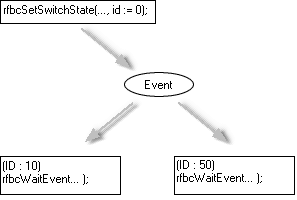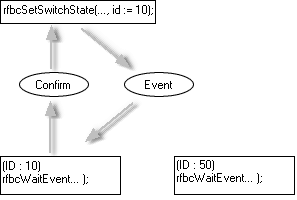The RFBC functions offer bidirectional communication functionality for close to medium range wireless communication in the ISM frequency band.
The RFBC functionality requires that RF is present. The RF functionality is not available on all RTCU products. Therefore please refer to the technical documentation on the specific product for further information.
The RFBC protocol offers safe bidirectional communication with increased operational reliability and provides the basis for an extensive range of devices for remote control and monitoring.
To increase the security of systems that use the RFBC protocol, the concept of pairing devices is utilized. Pairing is a way to associate a sender (for example a remote control) with a receiver (for example a switch adapter) so that the receiver will only accept requests from that specific sender.
The RFBC protocol requires devices to have a unique ID which is used to identify the sender and receiver when sending requests and receiving confirmations. If a receiver ID of zero is used when sending a request, it is considered to be broadcast to all receivers and no confirmation is returned.
The illustrations below shows the difference between a normal request and a broadcast request.
Broadcasting |
Addressing |
|
|
|
|
When the receiver ID is zero, the request is broadcast to any listening devices regardless of their IDs. |
When the receiver ID is not zero, only the device with the ID will receive the request. Reception will be confirmed by sending a confirmation back. |
Please note that some devices will not accept broadcast requests or will only accept broadcast requests until they are paired.
The RFBC protocol is designed to be compatible with other home automation systems, like the HomeMatic system, and is verified to work with the following products:
Manufacturer |
Type/Model |
Description |
eQ-3 AG. |
HM-RC-4-B / HM-RC-4. |
4 buttons remote control. |
eQ-3 AG. |
HM-RC-Key3. |
3 buttons remote control. |
eQ-3 AG. |
HM-PBI-4-FM. |
4 channel push-button remote. |
eQ-3 AG. |
HM-LC-Sw2-FM. |
2 channel flush-mount switch adapter. |
eQ-3 AG. |
HM-LC-Sw1-P. |
1 channel socket switch adapter. |
eQ-3 AG. |
HM-WDS30-T-O. |
Outdoor temperature sensor. |
eQ-3 AG. |
HM-Sec-MDIR. |
Indoor motion sensor. |
.
For technical information on the above products, please see www.homematic.com.
Architecture of the RFBC API
The RFBC API is based on an event-based model where the function rfbcWaitEvent is used to return information about the various events generated from compatible products. Incoming events are only received and handled as long as a thread is waiting for an event by calling rfbcWaitEvent.
It is possible to send events/requests while another thread is waiting for incoming events and it is therefore encouraged to use multithreading to accomplish a responsive application.
Please consult rfbcWaitEvent for detailed information about the various events and how they are handled.
The following RFBC functions are available:
Queries if RFBC functionality is present. |
||
Opens the RFBC interface. |
||
Closes the RFBC interface. |
||
Reads configuration parameters. |
||
Writes configuration parameters. |
||
Waits for an event (request or notification) to occur. |
||
Gets pair request. |
||
Gets raw/filtered event. |
||
Sets the raw event filter. |
||
Sends a raw RFBC packet/event. |
||
Gets remote control event. |
||
Gets switch change notification. |
||
Gets temperature notification. |
||
Gets remote sensor notification. |
||
Sends an acknowledge to the last received packet. |
||
Sends a button press event. |
||
Sends a switch change request. |

